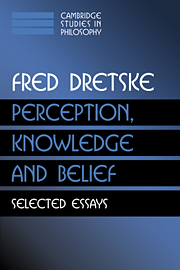Book contents
5 - Two Conceptions of Knowledge: Rational vs. Reliable Belief
Published online by Cambridge University Press: 19 December 2009
Summary
There are two ways to think about knowledge. One way is to start, so to speak, at the bottom. With animals. The idea is to isolate knowledge in a pure form, where its essential nature is not obscured by irrelevant details. Cats can see. Dogs know things. Fido remembers where he buried his bone. That is why he is digging near the bush. Kitty knows where the mouse ran. That is why she waits patiently in front of the hole. If animals are not conceptually sophisticated, do not posses language, do not understand what it takes to know, then this merely shows that such talents are not needed to know.
If, then, pursuing this strategy, you want to find out what knowledge is, look at what Fido has when he sees where his food bowl is or remembers where he buried his bone. Think about Kitty as she stalks a bird or pursues a mouse. And this, whatever it is, is exactly what we've got when we know that the universe is over ten billion years old and that water is the ash of hydrogen. It is true that in its grander manifestations (in science, for example) knowledge may appear to be totally beyond Fido's and Kitty's modest capacities, but this is simply a confusion of what is known (recondite and well beyond their grasp) with knowledge itself – something they have (albeit about more humble topics) in great profusion.
- Type
- Chapter
- Information
- Perception, Knowledge and BeliefSelected Essays, pp. 80 - 94Publisher: Cambridge University PressPrint publication year: 2000
- 18
- Cited by

